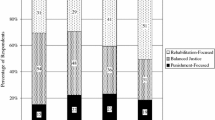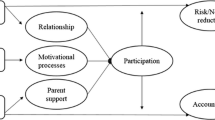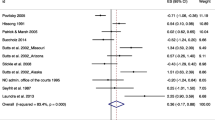Abstract
Probation officers are the focal point for most interventions with delinquent youths in the juvenile justice system. The present study examines probation strategies and interventions in a sample of 308 probation officers who completed the Probation Practices Assessment Survey (PPAS) in a web-based survey. The PPAS measures six probation approaches: deterrence, restorative justice, treatment, confrontation, counseling, and behavioral tactics. Structural equation models and latent class analyses showed that probation officers use multiple approaches with delinquent youths consistent with the balanced and restorative justice movement. Younger youths, high-risk youths, and youths with prior social service involvements are likely to receive more intensive interventions. The implications of these findings for improving probation practices with delinquent youth are discussed.
Similar content being viewed by others
References
Allison, P. D. (2002). Missing data. Thousand Oaks: Sage.
Bazemore, G. (1999). The fork in the road to juvenile court reform. The Annals of the American Academy of Political and Social Science, 564, 81–108. doi:10.1177/0002716299564001006.
Bazemore, G., & Schiff, M. (2005). Juvenile justice reform and restorative justice: Building theory and policy from practice. Portland, OR: Willan Publishing.
Bazemore, G., & Terry, W. C. (1997). Developing delinquent youths: A reintegrative model for rehabilitation and a new role for the juvenile justice system. Child Welfare, 76, 665–716.
Bazemore, G., & Walgrave, L. (1999). Restorative juvenile justice: Repairing the harm of youth crime. Monsey, NY: Criminal Justice Press.
Becker, G. S. (1976). Economic approach to human behavior. Chicago: University of Chicago Press.
Bender, V., King, M., & Torbet, P. (2006). Advancing accountability: Moving toward victim restoration. Juvenile & Family Court Journal, 57, 53–67.
Bishop, D. M., & Frazier, C. E. (1996). Race effects in juvenile justice decision-making: Findings of a statewide analysis. Journal of Criminal Law and Criminology, 86, 392–414. doi:10.2307/1144031.
Burnett, R., & Roberts, C. (Eds.). (2004). What works in probation and youth justice: Developing evidence-based practice. Portland, OR: Willan Publishing.
Butts, J., Mayer, S., & Ruth, G. (2005). Focusing juvenile justice on positive youth development. Chicago, IL: Chapin Hall Center for Children.
Chesney-Lind, M., & Sheldon, R. G. (1998). Girls, delinquency, and juvenile justice (2nd ed.). Belmont, CA: West/Wadsworth.
Cleland, C. M., Rothschild, L., & Haslam, N. (2000). Detecting latent taxa: Monte Carlo comparison of taxometric, mixture model, and clustering procedures. Psychological Reports, 87(1), 37–47. doi:10.2466/PR0.87.5.37-47.
Feld, B. C. (2005). Race and the jurisprudence of juvenile justice: A tale in two parts, 1950–2000. In D. F. Hawkins & K. Kempf-Leonard (Eds.), Our children, their children: Confronting racial and ethnic differences in American juvenile justice (pp. 122–166). Chicago: The University of Chicago Press.
Flexnor, B., & Baldwin, R. N. (1914). Juvenle courts and probation. New York: The Century Co.
Gaarder, E., Rodriguez, N., & Zatz, M. (2004). Criers, liars, and manipulators: Probation officers’ views of girls. Justice Quarterly, 21, 547–578. doi:10.1080/07418820400095901.
Giblin, M. J. (2001). Using police officers to enhance the supervision of juvenile probationers: An evaluation of the Anchorage CAN program. Crime and Delinquency, 48, 116–137. doi:10.1177/0011128702048001005.
Goodstein, L., & Sontheimer, H. (1997). The implementation of an intensive aftercare program for serious juvenile offenders: A case study. Criminal Justice and Behavior, 24, 332–359. doi:10.1177/0093854897024003002.
Graham, S., & Lowery, B. S. (2004). Priming unconscious racial stereotypes about adolescent offenders. Law and Human Behavior, 28, 483–504. doi:10.1023/B:LAHU.0000046430.65485.1f.
Griffin, P., & Torbet, P. (2002). Desktop guide to good juvenile probation practice. Pittsburgh, PA: National Center for Juvenile Justice.
Guarino-Ghezzi, S., & Loughran, E. J. (2004). Balancing juvenile justice (2nd ed.). New Brunswick, NJ: Transaction Publishers.
Hansen, D. J., & Warner, J. E. (1994). Treatment adherence of maltreating families: A survey of professionals regarding prevalence and enhancement strategies. Journal of Family Violence, 9, 1–19. doi:10.1007/BF01531965.
Hoge, R. D. (2002). Standardized instruments for assessing risk and need in youthful offenders. Criminal Justice and Behavior, 29, 380–396. doi:10.1177/0093854802029004003.
Hoge, R. D., & Andrews, D. A. (2003). The youth level of service/case management inventory (YCS/CMI): Intake manual and item scoring key. Carleton University.
Howell, J. C. (2003). Preventing & reducing juvenile delinquency: A comprehensive framework. Thousand Oaks, CA: Sage.
Hu, L., & Bentler, P. M. (1999). Cutoff criteria for fit indexes in covariance structure analysis: Conventional criteria versus new alternatives. Structural Equation Modeling, 6, 1–55.
Kline, R. B. (2004). Principles and practice of structural equation modeling (2nd ed.). New York: Guilford Press.
Kurlychek, M., Torbet, P., & Bozynski, M. (1999). Focus on accountability: Best practices for juvenile court probation. Washington, DC: U.S. Department of Justice, Office of Justice Programs, Office of Juvenile Justice and Delinquency Prevention.
Lane, J., Turner, S., Fain, T., & Sehgal, A. (2005). Evaluating an experimental intensive juvenile probation program: Supervision and official outcomes. Crime and Delinquency, 51, 26–52. doi:10.1177/0011128704264943.
Lane, J., Turner, S., Fain, T., & Sehgal, A. (2007). Implementing “Corrections of Place” ideas: The perspective of clients and staff. Criminal Justice and Behavior, 34, 76–95. doi:10.1177/0093854806288436.
Leiber, M. J., & Fox, K. C. (2005). Race and the impact of detention on juvenile justice decision making. Crime and Delinquency, 51(4), 470–497. doi:10.1177/0011128705275976.
Leiber, M. J., Schwarze, K., Mack, K. Y., & Farnworth, M. (2002). The effects of occupation and education on punitive orientations among juvenile justice personnel. Journal of Criminal Justice, 30, 303–316. doi:10.1016/S0047-2352(02)00131-9.
Lipsey, M. W., & Wilson, D. B. (1998). Effective intervention for serious juvenile offenders. In R. Loeber & D. P. Farrington (Eds.), Serious & violent juvenile offenders (pp. 313–345). Thousand Oaks, CA: Sage Publications.
MacDonald, J. M., & Chesney-Lind, M. (2001). Gender bias and juvenile justice revisited: A multiyear analysis. Crime and Delinquency, 47(2), 173–195. doi:10.1177/0011128701047002002.
Maloney, D., Romig, D., & Armstrong, T. (1988). The balanced approach to juvenile probation. Juvenile & Family Court Journal, 39, 1–4.
Matsueda, R. L., Kreager, D. A., & Huizinga, D. (2006). Deterring delinquents: A rational choice model of theft and violence. American Sociological Review, 71, 95–122.
McLachlan, G. J., & Peel, D. (2000). Finite mixture models. New York: Wiley.
Minor, K. I., & Elrod, H. P. (1990). The effects of a multi-facetted intervention on the offense activities of juvenile probationers. Journal of Offender Counseling, Services, & Rehabilitation, 15, 87–108.
Minor, K. I., & Elrod, H. P. (1994). The effects of a probation intervention on juvenile offenders’ self-concepts, loci of control, and perceptions of juvenile justice. Youth & Society, 25, 490–511. doi:10.1177/0044118X94025004004.
Muthen, L. K., & Muthen, B. O. (1998–2006). Mplus user’s guide (4th ed.). Los Angeles, CA: Muthen & Muthen.
Polcin, D. L., & Greenfield, T. K. (2003). Factors associated with probation officers’ use of criminal justice coercion to mandate alcohol treatment. The American Journal of Drug and Alcohol Abuse, 29, 647–670. doi:10.1081/ADA-120023463.
Pullmann, M. D., Kerbs, J., Koroloff, N., Veach-White, E., Gaylor, R., & Seiler, D. (2006). Juvenile offenders with mental health needs: Reducing recidivism using wraparound. Crime and Delinquency, 52, 375–397. doi:10.1177/0011128705278632.
Quinn, W. H., & Van Dyke, D. J. (2004). A multiple family group intervention for first time juvenile offenders: Comparisons with probation and drop-outs on recidivism. Journal of Community Psychology, 32, 177–2004. doi:10.1002/jcop.10085.
Rooney, R. H. (1992). Strategies for work with involuntary clients. New York: Columbia University Press.
Schafer, J. L. (1997). Analysis of incomplete multivariate data. New York: Chapman & Hall.
Schafer, J. L., & Graham, J. W. (2002). Missing data: Our view of the state of the art. Psychological Methods, 7, 147–177. doi:10.1037/1082-989X.7.2.147.
Schwalbe, C. S., Fraser, M. W., & Day, S. H. (2007). Predictive validity of the Joint Risk Matrix with juvenile offenders: A focus on gender and race/ethnicity. Criminal Justice and Behavior, 34, 348–361. doi:10.1177/0093854806292244.
Schwalbe, C. S., Fraser, M. W., Day, S. H., & Cooley, V. (2006). Classifying juvenile offenders according to risk of recidivism: Predictive validity, race/ethnicity, and gender. Criminal Justice and Behavior, 33, 305–324. doi:10.1177/0093854806286451.
Shearer, R. A. (2002). Probation strategies of juvenile and adult pre-service trainees. Federal Probation, 66, 33–37.
Skeem, J. L., Emke-Francis, P., & Louden, J. E. (2006). Probation, mental health, and mandatory treatment: A national survey. Criminal Justice and Behavior, 33, 158–184. doi:10.1177/0093854805284420.
Skeem, J. L., Encandela, J., & Louden, J. E. (2003). Perspectives on probation and mandated mental health treatment in specialized and traditional probation departments. Behavioral Sciences & the Law, 21, 429–458. doi:10.1002/bsl.547.
Skeem, J. L., Louden, J. E., Polaschek, D., & Camp, J. (2007). Assessing relationship quality in mandated community treatment: Blending care with control. Psychological Assessment, 19(4), 397–410. doi:10.1037/1040-3590.19.4.397.
Snyder, H. N., & Sickmund, M. (2006). Juvenile offenders and victims: 2006 National Report. Washington, DC: U.S. Department of Justice, Office of Justice Programs, Office of Juvenile Justice and Delinquency Prevention.
Steiner, B., Prukiss, M., Kifer, M., Roberts, E., & Hemmens, C. (2004). Legally prescribed functions of adult and juvenile probation officers: Worlds apart? Journal of Offender Rehabilitation, 39, 47–67. doi:10.1300/J076v39n04_04.
Torbet, P., & Thomas, D. (2005). Advancing competency development: A white paper for Pennsylvania. Pittsburgh, PA: National Center for Juvenile Justice.
Vidal, S., & Skeem, J. L. (2007). Effect of psychopathy, abuse, and ethnicity on juvenile probation officers’ decision-making and supervision strategies. Law and Human Behavior, 31, 479–498. doi:10.1007/s10979-006-9077-1.
Walsh, A. (2001). Correctional assessment, casework, and counseling (3rd ed.). Alexandria, VA: American Correctional Association.
Ward, D. A., Stafford, M. C., & Gray, L. N. (2006). Rational choice, deterrence, and theoretical integration. Journal of Applied Social Psychology, 36, 571–585.
Wiebush, R. G. (1993). Juvenile intensive supervision: The impact on felony offenders diverted from institutional placement. Crime and Delinquency, 39, 68–89. doi:10.1177/0011128793039001005.
Wright, B. R. E., Caspi, A., Moffitt, T. E., & Paternoster, R. (2004). Does the perceived risk of punishment deeter criminally prone individuals? Rational choice, self-control, and crime. Journal of Research in Crime and Delinquency, 41, 180–213. doi:10.1177/0022427803260263.
Young, P. V. (1937). Social treatment in probation and delinquency: Treatise and casebook for court workers, probation officers and other child welfare workers. New York: McGraw-Hill.
Zhang, S. X. (1997). The efficiency of working under one roof: An evaluation of Los Angeles County juvenile justice centers. Crime and Delinquency, 42, 257–268. doi:10.1177/0011128796042002007.
Acknowledgment
The authors wish to acknowledge the assistance of Diane Kinkaid and the staff of the American Probation and Parole Association for their assistance with this study.
Author information
Authors and Affiliations
Corresponding author
About this article
Cite this article
Schwalbe, C.S., Maschi, T. Investigating Probation Strategies with Juvenile Offenders: The Influence of Officers’ Attitudes and Youth Characteristics. Law Hum Behav 33, 357–367 (2009). https://doi.org/10.1007/s10979-008-9158-4
Received:
Accepted:
Published:
Issue Date:
DOI: https://doi.org/10.1007/s10979-008-9158-4




